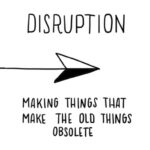
Startups all, struggle with a question of what’s called, “valuation.” What is the company worth? To put together a pitch deck, negotiate terms with investors, or just to share with potential team members and advisors what you’re doing, people will want to know what it’s worth now.
Before you take money from a venture capital firm, you’ll agree to a valuation and that valuation will also affect how much of your company you continue to own, depending on how you part with shares of the company in order to raise that capital. Being prepared to discuss your valuation, appreciating what is considered, and understanding how it works, is more important that figuring out a precise value, so let’s explore an easy way to think about valuations.
Cutting to a chase… valuation is in many respects more art than science.
Particularly early, it’s a matter of perspective and opinion. There are some patterns and norms that have emerged over the years, and as founders seek to learn how to make sure they’re at least in the right neighborhood, how do we make sure we’re roughly right?
Article Highlights
Accounting for Revenue
That vaunted of startup metrics!
Everyone talks about revenue as if it’s the most important thing in the world. Here’s the trick, a new business, with a known business model, can certainly argue that it should have revenue whereas a “startup” without a known model, frankly can’t. All this talk of revenue is misleading and you should be empowered to reply confidently to an advisor/investor who asks about revenue, “WTF do you mean revenue??“
Here’s how and why.
Revenue actually isn’t typically factored heavily into “startup” valuations because startup means you don’t know the business model yet (you’re still figuring it out); revenue is just an indicator that you can sell something of value… not necessarily create a fundable company.
That is, for example, service based businesses start all the time and drive revenue, heck, place a phone call and you may be able to “start” something right now that has revenue.
That neither a “startup” nor fundable company makes
That fact, is reasonably well conveyed in appreciating innovation vs. service, and then thinking about that difference by stage of your new venture: A pure innovation with no revenue (brand new) is worth what it costs someone else to build it. An invention or a patent. A pure service oriented business, with $20,000 in revenue, years in the making of the business, is worth a slight multiple of that much because people would buying the book of business. An agency, for example. Follow? If all you’ve done is start a service business OR invent something / have an idea, it’s essentially worth *that*
$10k for someone else to build it? It’s worth $10k, no matter what it cost you to get develop the same thing
With revenue, in a pure innovation, clearly that invention is worth something more; what it costs build or license it, TIMES 2.
$10k for someone else to build it… you have $20k in revenue per year = $50k
This is why patents really aren’t worth anything at an early stage… just because you have revenue on the thing, doesn’t mean it’s worth much more than what it is. Revenue x2 OR what it costs to build.
A pure service based business (that agency or development firm) is generally considered to be worth 2-4x revenue. What people would be buying is really only the people and book of business you have… and people (employees) leave so…
$20k in revenue with no innovation = $60k
Tech enabled service businesses can creep that a little higher – 3-5x revenue (presuming the tech and skills in place are worth more in actually growing the business and not being dependent on that team of people). Innovation with service oriented skills (e.g. marketing & sales) is where we start seeing far higher valuations – further varied from that estimation, given the team and market.
Great, so… How do I value a “startup”? Essentially, it’s this…
Tech Enabled Service??
A technology company is an organization that wouldn’t (indeed, couldn’t) exist if it weren’t for technology.
A tech enabled service uses existing tools, platforms, libraries, and frameworks to make a company or a solution it provides more efficient or effective.
Given the above, let’s say have a great team of engineers and marketers and you’ve build something that ticks up into that 3-5x range.
$100k in revenue… it’s worth $500k
But you’re likely in a situation where you don’t really have revenue yet. Apply a matrix such as this.
| Strength of entrepreneur and team | 30% weight |
| Product / Tech | 15% weight |
| Exit scenarios | 10% weight |
| Size of opportunity | 10% weight |
| Competition | 10% weight |
| Growth rate | 10% weight |
| Marketing & Partnerships | 10% weight |
| Need additional investment | 5% weight |
| Other (i.e. customer sentiment) | 5% weight |
Perhaps you’re seeing that the team, innovation, and marketing related considerations are most important? That’s because they are.
The weighting of each of those considerations provides a means of calculating an estimation of value derived from what you actually have now.
To do that, we add to the matrix a 100% estimation of each. A lower % being bad for you and a higher % being good for you. How do you know what to put? Recall my statement above, “valuation is in many respects more art than science” and how I’ve just referred to it as an estimation.
Be thoughtful, pragmatic, and honest.
What you’re trying to derive is a reasonable and defendable number. This methodology and matrix gives you means of understanding how valuation tends to be worked out, while also arming you with explanations to defend or debate your point of view.
Lacking team that capable team? Call it 80% then, or worse.
Incredibly ideal and experienced team? Maybe score yourself higher and overweight at 110%.
Get the idea? If bad, use a lower % and if good for you, higher. Is Competition stiff? That’s not good. Need additional investment….but that’s a good thing for you? Great, lean in that direction on the %. If it’s bad that you *need* capital and you can’t be successful without…
Let’s update the matrix
| Strength of entrepreneur and team | 30% weight | 70% |
| Product / Tech | 15% weight | 90% |
| Exit scenarios | 10% weight | 110% |
| Size of opportunity | 10% weight | 100% |
| Competition | 10% weight | 60% |
| Growth rate | 10% weight | 20% |
| Marketing & Partnerships | 10% weight | 50% |
| Need additional investment | 5% weight | 80% |
| Other (i.e. customer sentiment) | 5% weight | 90% |
My third column is our assessment of our startup. To help make the logic clearer, notice, as our example, I’m estimating based one known companies that want to acquire us and that it’s a big opportunity (high scores) but that our growth rate is pretty terrible and our marketing is lacking, evident in both Marketing & Partnership and a softening of the team score.
Our WEIGHTS add up to 100% so if everything is 100%, the impact on our valuation is just that: (see above) what it costs to make, and our revenue (more or less) = what it’s worth right now. But below or above 100% overall, adjusts our value so as to account for other things that matter.
The outcome of my scenario here is 77% (weight * estimation added all together).
Let’s take our $500k estimation from above and now we have $385,000
Yuck. Not happy about that? Think you’re worth more??
See why you’re not? You invested money to build something and you have some revenue, great. But our estimations roll out that you likely can’t compete, aren’t growing, and really aren’t the ideal team, so are you actually worth just what’s on paper OR is someone investing/acquiring you going to have to fix some of those things?
Look at it instead through a more positive estimation to see why it works
| Strength of entrepreneur and team | 30% weight | 110% |
| Product / Tech | 15% weight | 90% |
| Exit scenarios | 10% weight | 120% |
| Size of opportunity | 10% weight | 140% |
| Competition | 10% weight | 60% |
| Growth rate | 10% weight | 170% |
| Marketing & Partnerships | 10% weight | 110% |
| Need additional investment | 5% weight | 90% |
| Other (i.e. customer sentiment) | 5% weight | 130% |
Great team, lot’s of growth, bigger opportunity, and we know how to develop that, people love it…. 118% impact and our $500k simple estimation is closer to $600k
Keep in mind, this entire point of view and article is largely based on PRE funding (and likely pre revenue); so if the numbers still feel small to you, that’s because they are at that point.
You’re seeking your seed round from here and let’s say that will put $2,000,000 of raw capital into the company. That’s direct value so our basis is now $2,500,000 given the original $500k estimation and $2M in.
The venture capital industry uses terms like pre-money valuation and post-money valuation (I’m not going to get into those here so as to not distract you from the basics to appreciate how it works – you can learn more here if you’d like)
Now, with more capital or value as your basis, obviously a multiplier means a lot more. Armed with some perspective, you can justify that all that you do is worth more than the obvious, even with the capital investment; 118% estimation turns $2.5M “post-money valuation,” into a company arguably heading toward $3,000,000 and more as you go.
There are countless and very involved modeling sheets, basic ways to think about it, and every advisor or investor out there has their opinion of the factors and importance of each. End of the day, the estimations are roughly the same, and what matters most is that you, the founder, are prepared to talk about it. What ends up being debatable is the % assessment of each of the considerations – You say the team is stellar and 120%… they say, “eh… 70%.”
Now you have something to talk about.
Lost in the Weeds
- The Comparable Pricing Method.
- The Scorecard Method.
- The Discounted Cash Flow Method.
- The “Cost to Duplicate” Method.
- The Risk Factor Summation Method.
It’s art as much as science. Or rather, there are norms and reasonable ranges more than precision. Focus on how we think about it, bury in your brain the intentions and considerations behind that, and you’re in great shape to capably talk about startup valuation.
I want to invite you to join me in such discussions live and together.
Join me online here








And yet, valuation is still debated. I’ve actually been told that our pre-money is too low. Yet we haven’t done the raise
Jay Fraser it will forever be debated. Should be added to that list with Death and Taxes on it…
This is definitely Paul’s approach. It is educated and well articulated. There are definitely other educated and well-articulated approaches, too.
Ok. We have a completed/patented product; we’ve proven manufacturability, have early adopters and some revenue. Very experienced but two-man management team
I could support all of these arguments you make ( Paul O’Brien )
I feel that strength may be underestimated in your model. I know that we did our first round almost entirely on the competence of our team. A track record of execution and innovation is far more valuable (IMO) than an awesome idea and a green team.
I get the matrix. But how do you translate that into a dollar value? Seems like a foundational value would first need to be there to even apply the matrix? How I determined ours was just by taking a multiple comp (of revenue) of Patreon and then using that multiplied by $1M. The thinking was that if anyone invests they must first agree that we as a company can get to $1M in revenue and then multiplied by the multiple I have my valuation. No balking from our investors except for one but he still invested.
It’s in the article. Cost to build plus a multiple of revenue is the basis.
Paul O’Brien Read the article but clearly missed it. Sorry about that. I’ll need to see how you set it up when a company has no revenue yet.
Standard basis for everyone in that case is the cost for someone else to build the same thing. Then the weighted multiples.
Like pricing product, no calculations really matter (opinion / observation). It’s all about industry / geographic norms and what the market will accept. Especially prefunding.
Excellent !!!
The three biggest factors at raising pre-valuation are team, where you’re raising, and types of investors you’re raising from.
Roman Gonzalez indeed. Very true. Thrust of my goal was to help first time or unfamiliar founders, just get familiar with how to talk about it.
Yeah, you could just say, “we’re like that, and that’s worth X”
But inevitably then, investors ask about the details and helping justify the value (being able to talk about it) is what matters.
Thank you for sharing this matrix. I appreciate you going through the weeds with us on this. As a Commercial Real Estate Broker I find this very useful.
Interesting article (and for me personally, well timed). Thanks for sharing your insights!
Paul O’Brien Totally. And fwiw when I was in the thick of trying to figure out valuation in general, even later stage, it did very much look like what you proposed. And it’s helpful to have a framework like you proposed. The “eh, it’s what people say it is” was frustrating in the beginning, so I do relate to that.
Thanks my friend, both timely & informative!
Thanks for another nugget of wisdom! On point and much appreciated.
This is a great read. From top VC we are valued at 3.5-5mil pre-valuation.
Its really eye opening once you do research and speaks to VC or startups who were valued high even before profit or just an idea.
Also incredibly eye opening when you start hearing the different perspectives on that value, and then correlate WHY they have those opinions, drawn from their personal experiences, and seeing patterns emerge. Various types of investors give advise or have reactions based on their point of view, not necessarily what’s “right” (which is a subjective opinion in the world of entrepreneurship).
That matrix in your article is very impressive and a great reference for founders.
[…] some sense? Can you see how we can’t KNOW the valuation of an unfunded startup. No one […]
Paul, while I agree with the premise of traditional valuation being difficult, I believe the founders need to make a case for the value. Our guidance is a bit different, we’ve analyzed the history of 255k companies and their trajectories from seed to exit in different spaces, you can evaluate their stage, space, timing, amt. raised etc, relative to history and comparables to justify a reasonable value based on peers along with the current market climate. It’s an interesting dataset that is much less variable than institutional opinions which can be biased. It’s not easy but as we mature in the startup ecosystem data is our friend.
Brandon Knicely I don’t really disagree but you’re also sort of making my point, “We’ve analyzed the history of 255k companies and their trajectories from seed to exit in different spaces, you can evaluate their stage, space, timing, amt. raised etc, relative to history and comparables to justify a reasonable value based on peers along with the current market climate.”
That’s right. Thus, a founder can and should expect the VC/investor is better capable of assessing value of a new venture than an inexperienced and early stage focused founder. Frankly, a founder should expect that any investor they’d want to have is capable of doing this and harshly, I’d fear an “Angel” or “VC” who doesn’t have a clue how.
How can anyone capably make investments in startups if they have no idea how to determine values.
AND your first point. Yes, Founders should be familiar as well and should certainly make the case for their value. My point is, to leave it to the investor to lead Terms.
The ambiguity regarding valuations can work to the advantage of the founder or the investors. If nobody can value early stage startups exactly, then we as founders can always counter and ask for a better deal – and we might get it. By the same token, unless there’s far better deals on the table investors can ask for a better deal and perhaps get it, too. It’s important to come to terms that everyone can live with and is comfortable with. After-all both parties are in the same boat, and if they start off embittered instead of empowered that’s bad for everyone.
I agree that early stage startup valuations are arbitrary, but I disagree that the founder should not have a reasonable range of valuations in mind based on a de facto market, and tied to some known variables.
It was common knowledge that in 2021 in a frothy market top tier startups were able to raise from top tier investors $2M @$20M PM seeds (10% dilution)
A pre-seed of $10M was an equivalent high mark in that market.
Pre-pandemic standard was 20% dilution per round, which is tremendous variability.
I know a founder raising a pre-seed today at ~$7M PM and more than 20% dilution.
These are, of course, for top tier startups raising from top tier investors.
What makes a startup top tier? That’s a $64,000+ Q for another post.
But top tier early stage investors tend to focus on writing larger checks (~$1M) to secure a larger stake (ideally up to 10%), and are more focused on getting into top tier deals than equivocating over valuation – though they grumble about deal inflation on VC Twitter (though not so much lately).
That said I sense everyone loves a deal, but investors would likely press an advantage only if they felt they had leverage due to arguable risk factors in a startup – inexperienced founders, no revenue, etc.
The risk to asking investors to set valuation is you might get a range of answers and that might create new friction in the process.
However, getting feedback from 8-10 investors to set a range, and better yet securing a lead investor or even “first check” as social proof can anchor a range.
Investors that dig in below your range are not likely top tier. If they are really shooting for $B exits an entry at $5M or $10M or $20M is not as important so long as they have the capital and allocation to grab a large stake.
That last part was word for word from a VC earlier today.
Can’t keep silent this time. I can’t help but say this is situational advice presented extremely dogmatically.
I was just at two venture summits this week and many vcs and founders argue exactly the opposite. I’ve experienced the opposite sometimes being more successful.
I don’t have the time to keep up with Paul and write essays with all the reasoning, but I don’t think this is something a founder should “never” do.
Isaiah McPeak hopefully you know I never judge anyone for criticism. I write to learn (and teach), to provoke (and be provocative), and to guide while also getting guidance.
So though, I am going to challenge you.
Tell me how a pre funded startup can know their valuation?
Don’t give me a scenario; I’ve said it can’t be done accurately and you’re asserting that it can be. So please, teach us, elaborate: how? I’m open to learning and being wrong.
What did these VCs say other than disagreeing with me? They claimed it could be done, or they told you how?
Paul O’Brien already mincing words. I can’t keep up. And have been judged pretty harshly by you before right here ?
I didn’t use the word accurate. Your opening sentence, which is the thesis to which I object, doesn’t either.
Isaiah McPeak now I’m confused. So you object to my assertion that I advise startups to never state what they think their valuation is? How can you object to my statement of my actions?
I’m not trying to trick you up, the point of comments is to have a discussion so please, clarify; I’ll happily do the same.
(There is a difference between disagreement and judging criticism. I fully and entirely respect you and anyone stating I’m wrong and sharing your opinion! That doesn’t mean I won’t disagree with it)
Or let me propose a different way to show us I’m wrong…
What startup can you point to that had an accurate and correct valuation? If it can be done, it has been done, yes?
Valuations are determined by the market and if the public market (publicly traded companies) constantly fluctuate in value, we can be certain, as far as I know, that a startup *without* established financials, models, and groupthink, can’t possibly do better.
Paul O’Brien therefore all valuations are “accurate” once both sides agree.
Your post says something founders should never do. I don’t think it’s good advice.
Thanks for your time.
Isaiah McPeak that’s a fine way to put it and think about it. I don’t disagree with both sides finding agreement on what they think is accurate.
Paul O’Brien I’ve learned if you have a good enough business model and product SAVY investors will put money in on SAFE Notes all day long!